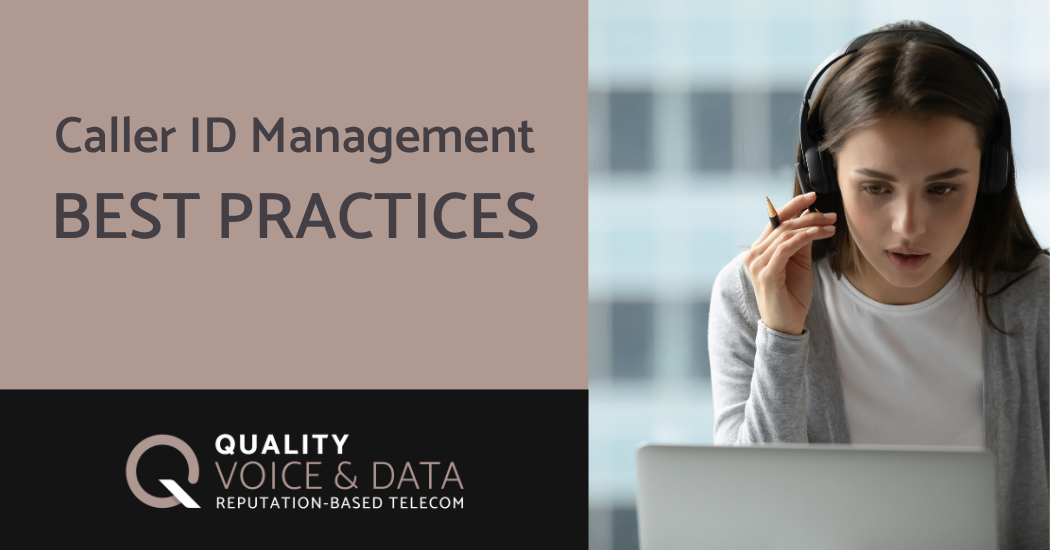Mastering the art of caller ID management isn't just important—it's a game-changer for businesses and call centers navigating the complex world of modern communication. Imagine a world where every call you make not only reaches your audience but also resonates with them. That's the power of effective caller ID management. In this comprehensive guide, we're diving deep into the heart of this critical strategy. From unveiling the mysteries of caller ID to showcasing the revolutionary services of Quality Voice & Data (QVD), we're here to transform your approach to outbound calls and open a new chapter in customer engagement.
What is Caller ID Management?
Caller ID management is an all-encompassing process that involves controlling and customizing the information shown on the recipient’s phone during a call. This process is particularly critical in outbound calling campaigns for businesses and call centers.
Key Components:
Display Control: Selecting the phone number and associated name (CNAM) that appear on recipients’ caller IDs.
Accuracy and Compliance: Ensuring the displayed information is accurate and adheres to legal standards, including the Truth in Caller ID Act.
Strategic Usage: Utilizing local or specific numbers strategically to foster familiarity and trust with the target audience.
Why Accuracy is Essential:
Building Trust: Accurate caller IDs engender trust among recipients, increasing the likelihood of calls being answered and facilitating effective communication.
Combating Negative Perception: Inaccurate or deceptive caller IDs can lead to a negative perception, potentially causing calls to be ignored or blocked, which is particularly damaging for legitimate businesses.
Enhancing Answer Rates: Accurate and local caller IDs significantly boost answer rates as people are more responsive to familiar or local numbers.
Regulatory Compliance: Accurate caller IDs ensure adherence to laws and regulations aimed at preventing fraudulent telecommunication practices.
Improving Customer Experience: For businesses, accurate caller IDs are integral to enhancing customer experience, ensuring calls from recognizable numbers, thus reducing confusion and bolstering brand credibility.
Services like QVD’s Trusted Call Completion® and TrustedCaller™ programs are vital in maintaining caller ID integrity and boosting the effectiveness of outbound communication strategies.
Best Practices in Caller ID Management
- Utilize Local Caller ID Numbers: Employ local numbers in respective regions to increase answer likelihood and convey a more personal, credible touch.
A familiar area code resonates with customers, creating an instant connection that suggests the caller is from their community, which can lead to a higher rate of engagement. Local numbers remove the anonymity and distance often associated with out-of-area or unknown calls, thereby reducing the apprehension of answering. It allows businesses to present themselves as a part of the local landscape, which can also boost their credibility and approachability. This tactic not only benefits customer perception but also strategically leverages the psychological bias towards local entities, potentially increasing customer trust and the effectiveness of the communication.
- CNAM is Key: Choose a legally compliant CNAM for your caller ID to foster trust and recognition, reducing call rejection.
Transparency in caller identity fosters trust, and when people recognize the name appearing on their caller ID, they are more likely to feel comfortable engaging in conversation. It is crucial to adhere to legal compliances for CNAMs, as it not only instills confidence among customers but also ensures that the business practices responsible telecommunication behaviors, thus maintaining a positive brand reputation.
- Efficient Outbound Call Management: Implement systems to stay compliant and avoid “spam likely” designations
Businesses must navigate outbound calls carefully to avoid penalties and preserve their brand image. Properly managing the timing, frequency, and context of calls can help maintain compliance with these regulations while still making effective connections with potential clients.
- Regular Monitoring and Reporting: Use tools to gain insights into caller ID performance, enabling data-driven optimizations for better results and compliance.
Monitoring caller ID effectiveness helps identify which strategies are working and which need refinement. Regular monitoring enables quick responses to any issues, such as caller IDs being mistakenly marked as spam, and ensures that corrective measures can be implemented promptly to maintain a high level of performance and compliance with telecommunication standards.
The QVD Advantage in Caller ID Management
Quality Voice & Data offers state-of-the-art caller ID management services, utilizing technologies like Elastic SIP Trunking and robust call authentication to prevent call rejection and blocking. They provide clean Direct Inward Dialing (DID) numbers and real-time monitoring, enhancing campaign effectiveness. The TrustedCaller™ program ensures calls receive high attestation, bolstering answer likelihood and consumer trust. QVD's commitment to tailored solutions and outstanding customer service ensures the delivery of high-quality, clean local Caller ID numbers with continuous support.
Wrap-Up
Effective caller ID management is crucial for maintaining credibility, fostering customer trust, and boosting answer rates. By embracing these best practices and leveraging services like those offered by Quality Voice & Data, businesses can significantly optimize their outbound communication strategies.
Angela Garfinkel, Director at Quality Voice and Data, brings over 30 years of experience in call center and business process outsourcing. Well known in the telemarketing and telecommunications industry, she co-authored a course for The Direct Marketing Association and actively participates in professional groups like PACE. Her educational background includes an MBA and an undergraduate degree in Telecommunications Management from the University of Nebraska.
